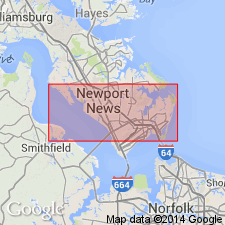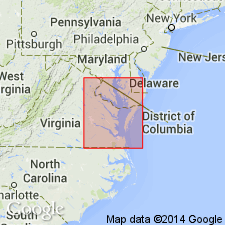
- Usage in publication:
-
- Sedgefield Member
- Modifications:
-
- Named
- Dominant lithology:
-
- Sand
- Clay
- AAPG geologic province:
-
- Atlantic Coast basin
Summary:
Sedgefield, lowermost member of Tabb Formation (new name), is here named in southeastern VA. Consists brackish-bay, lagoonal marsh, and nearshore marine deposits. Described as gray, tan to yellowish-brown, and bluish-gray, clayey and gravelly sand and clay. Base of unit is fossiliferous, cobbly, clayey, medium to coarse sand. Thickness is 3.5 m at the type section. Measures 1 m elsewhere. Unconformably overlies Yorktown or Norfolk Formations; unconformably underlies Lynnhaven Member (new name). Age is late Pleistocene.
Source: GNU records (USGS DDS-6; Reston GNULEX).

- Usage in publication:
-
- Sedgefield Member*
- Modifications:
-
- Overview
- AAPG geologic province:
-
- Atlantic Coast basin
Summary:
Late Pleistocene Tabb Formation and its three subdivisions, Sedgefield, Lynnhaven, and Poquoson Members, mapped west and south of Chesapeake Bay in the Virginia Coastal Plain. Thickness of Sedgefield ranges 0 to 50 ft. Age on coral averages 71,000+/-7,000 yrs. Tabb overlies middle Pleistocene Shirley Formation and underlies Holocene deposits.
Source: GNU records (USGS DDS-6; Reston GNULEX).

- Usage in publication:
-
- Sedgefield Member
- Modifications:
-
- Overview
- AAPG geologic province:
-
- Atlantic Coast basin
Summary:
Nomenclature on State map follows Johnson (1976). Sedgefield Member is lowest of three members of Tabb Formation. Described as pebbly to bouldery, clayey sand and fine to medium, shelly sand that grades upward into sandy and clayey silt. Locally, channel fill at base of unit includes up to 50 ft of fine to coarse cross-bedded sand and clayey silt and peat containing in-situ tree stumps. Sandy bay facies commonly contains CRASSOSTREA BIOSTROMES, MERCENARIA, ANADARA, POLYNICES, ENSIS, and other mollusks. Specimens of the coral ASTRANGIA have yielded estimated uranium-series ages averaging 71,000 +/-7,000 yr B.P. (Mixon and others, 1982). Unit is surficial deposit to river- and coast-parallel plains (altitude 20 to 30 ft) bounded on landward side by Suffolk and Harpersville scarps. Overlies Shirley Formation. Thickness ranges 0 to 50 ft. Age is late Pleistocene.
Source: GNU records (USGS DDS-6; Reston GNULEX).
For more information, please contact Nancy Stamm, Geologic Names Committee Secretary.
Asterisk (*) indicates published by U.S. Geological Survey authors.
"No current usage" (†) implies that a name has been abandoned or has fallen into disuse. Former usage and, if known, replacement name given in parentheses ( ).
Slash (/) indicates name conflicts with nomenclatural guidelines (CSN, 1933; ACSN, 1961, 1970; NACSN, 1983, 2005, 2021). May be explained within brackets ([ ]).

